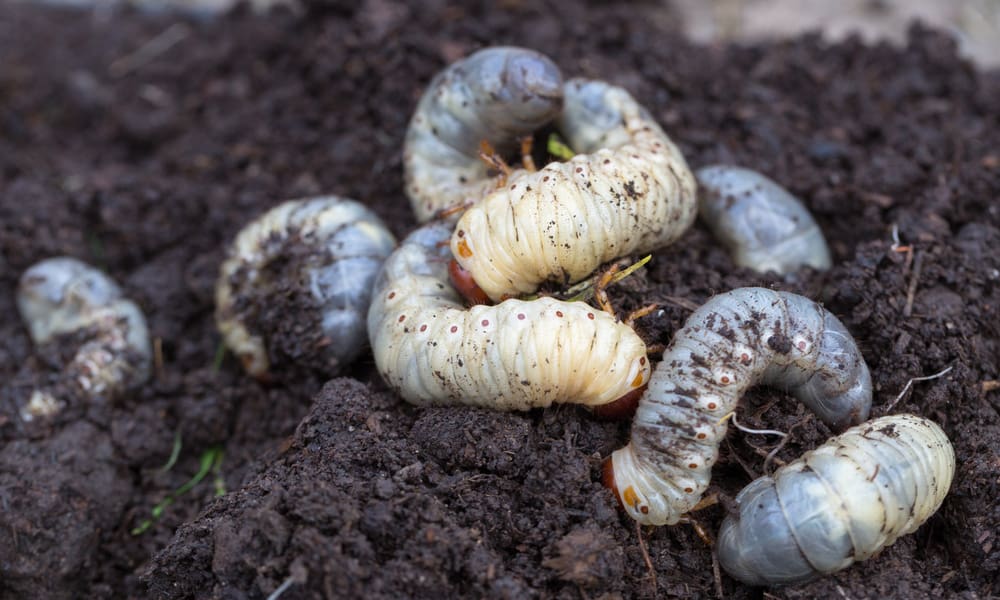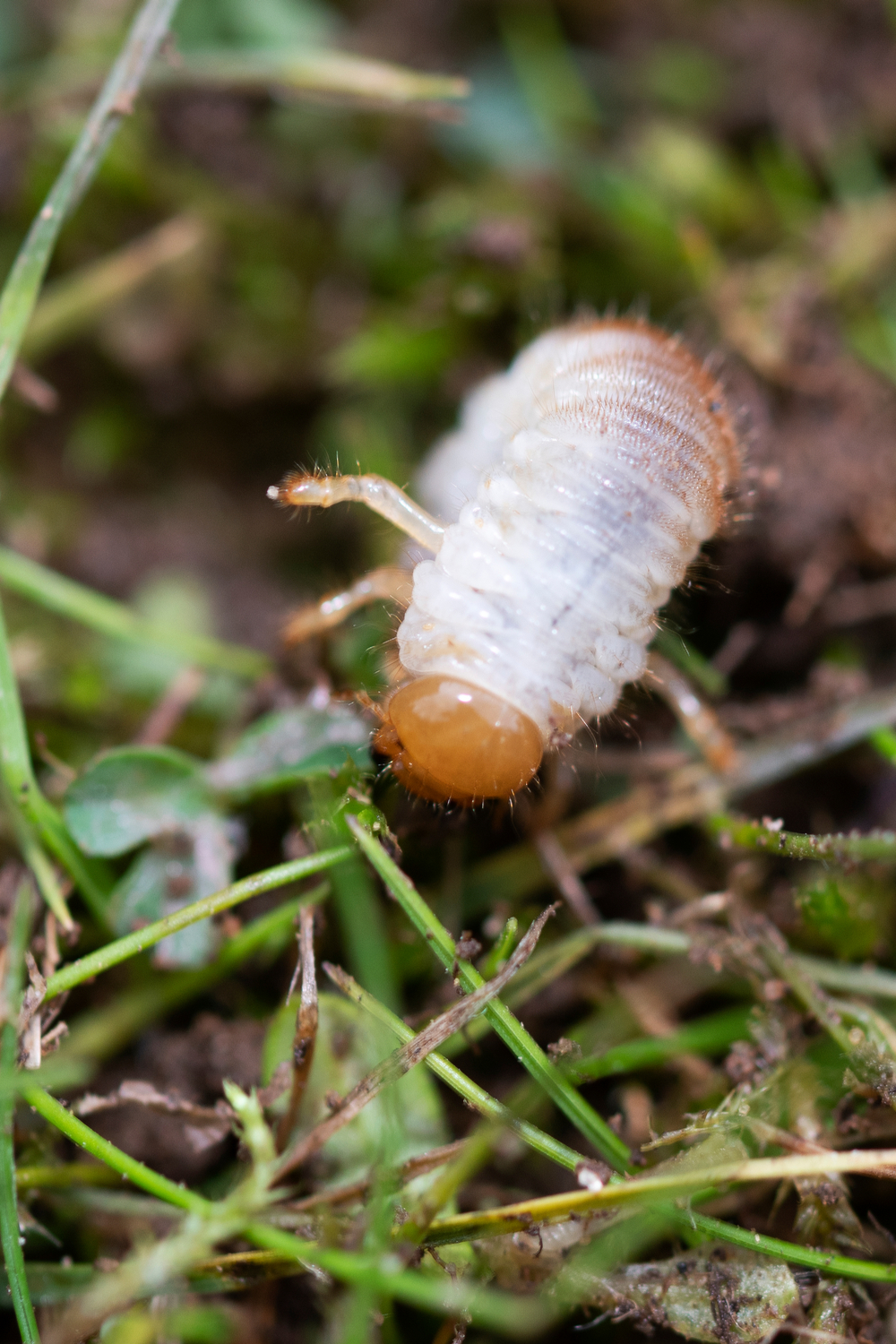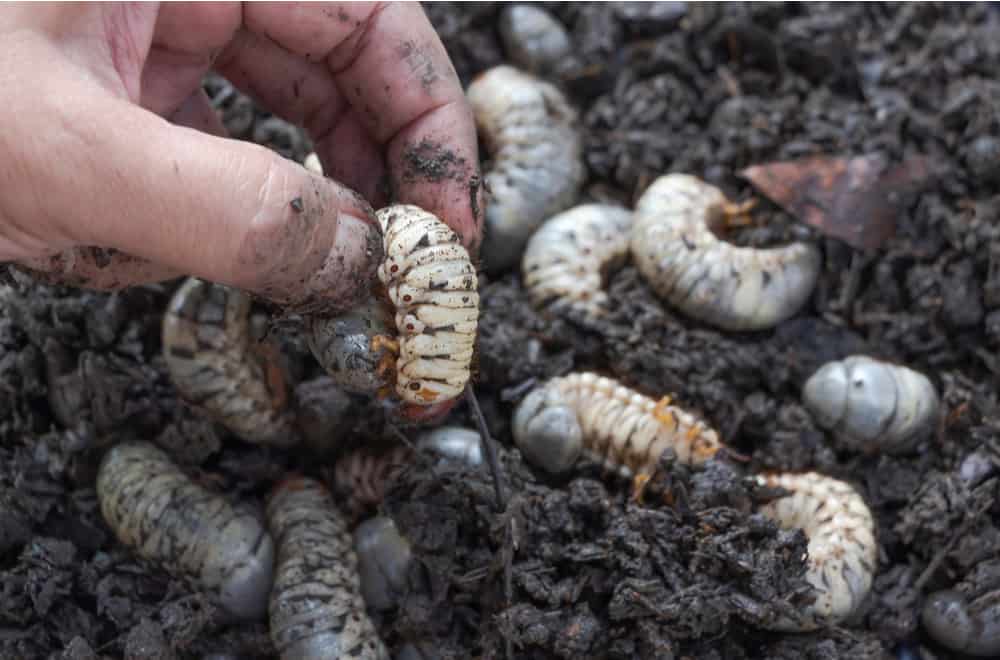Grubs are mostly food sources for other animals such as birds, skunks, and raccoons. These animals will dig up the ground to get their daily dose of nutrients from these bugs.
However, people know little on the subject “what do grubs eat?” Curious to learn?
What Do Grubs eat?
Grubs are the larvae stage of a variety of beetles. The most common species include the European chafer, June beetle, and Japanese beetle, which you can further classify as white grubs.
Grubs undergo four stages in their life cycles: Egg, Larvae, Pupa, and Adult. In the process, they vary in size, shape, color, and feeding habits. It will ultimately change where it lives during its life cycle.
All grub species complete their life cycles in one year, excluding the June beetle, which takes three years.
Adult female barn swallows lay their eggs in the grass between the mid and late seasons of summer. After hatching the 1st instar, larvae immediately begin to feed on grass. They do this for the first several weeks.
Grub worms overwinter deep in the soil as the grass freezes during winter. In summer, when the soil warms up, the grub resurfaces and carries on to feed. By this time, it’s at its 2nd and 3rd instar, increasing the amount of food it consumes.
Harm Of Grubs
Lawns begin to show grub damage in the late summer and early autumn. One or two grubs cannot do much harm. For there to be visible evidence of damage, the infestation must be severe.
The damage caused appears as dead patches of turfgrass that pull out easily or as heaps of turf grass dug over by raccoons or skunks.
Heavily infested lawns suffer more feeding damage. The damage first appears during August where one might mistake it for damage done by drought. But unlike drought-damaged grounds, the grass peels easily.
Other signs of damage include flocks of birds descending on the lawn or the damaged areas of the grass. Birds, skunks, and moles feeding on the grub will add to further damage to the lawn.
Species of grubs, such as Japanese beetles and June bugs, like to lay their eggs on lawns. Once they hatch, it becomes difficult to control the infestation
Root damage is caused on the lawn when grubs feed on it, causing the grass to wilt and lose color, turning into an undesirable brown color.
Aside from the lawn, grub attacks crops at all stages of growth. This behavior, in turn, causes stunted growth, wilting, and infestation of other plants in a row.
In North America, white grubs feed on the roots of corn, Kentucky, timothy, bluegrass, soybean, sorghum, potato, strawberry, and other cultivated crops. The damage caused by root feeding can be so severe that plants may not grow any taller than 30-60 centimeters.
When the root system is severely damaged, the injured plants ultimately die and are easily pulled out from the ground.
Attack on crops or lawns by white grubs leads to reduced yield in crops. White grubs are sensitive to different types of soils, and hence their attacks are never uniform. Therefore, in the same field, some areas are completely damaged, whereas others remain entirely unaffected.
Tips To Get Rid Of Grubs
As previously mentioned, grubs damage your crops or lawn by munching on the roots. Eventually, they turn into adult beetles that feed on the leaves of the plants on your garden or farm.
Aside from using chemicals (insecticides or herbicides) to control grub infestations, there are natural methods you could employ to get rid of them.
To treat your yard of grub, you must first be able to identify if it is genuinely a grub infestation that’s causing all the damage in your yard. The following are steps to identifying the presence of grubs.
- Search for signs of grub infestations in your yard or lawn –these usually include irregular brown patches of dead grass. In addition, look out for other symptoms like holes in your lawn, grass with no roots, or a spongy feeling when you touch or walk in them.
- Check for grub worms –once you find evidence of their presence, the next step is to inspect the ground for their larvae.
Do this by using a spade to dig up one square foot (e.g., 30 by 30 centimeters) portions where the dead grass meets the unaffected grass and check for c-shaped bugs with no legs. If you find the larvae, you have a grub infestation!
- Decide whether or not you need to treat it. Depending on the grubs’ numbers, you may not need to treat your lawn. For example, if you find five but less than ten per square foot, you should treat your yard.
The best time to treat your lawn against grubs is in springtime or autumn when they actively feed. Below are some tips you could use to eliminate them:
- Use earth-friendly nematodes (e.g., roundworms) to seek out and kill these soil-inhabiting insects. They can be bought in stores and come in sponges that you soak and pour the resulting liquid into a spray bottle. Over time, the nematodes multiply and will hunt and kill grubs.
- Introducing insect-eating birds such as wrens – strategically set up their houses in your yard so they do not spot each other as they are territorial. The birds will seek out and feed on the grubs, eliminating them from your yard.
- Use the natural-occurring milky spore disease (Bacillus papillae) – will harm and kill beetles in your yard without damaging your crops or lawn. However, this process may take time to take effect. As you wait for the milky spore to take effect, you can make use of the beneficial nematodes.
- Use of organic fertilizers – synthetic fertilizers kill beneficial nematodes that help eliminate beetles. An alternative is to use organic fertilizers that support the growth and spread of beneficial nematodes.
- Use natural oils in your yard – mix neem oil and water as directed by the product’s instructions and spray on the affected parts of your lawn to stop grubs from laying their eggs and keep them from feeding.
- Plant seeds and fertilize your lawn in autumn – beetles don’t lay eggs in long and bushy grass. Through seeding and fertilizing, you can repair the damaged parts of your yard and prevent new beetles from laying additional eggs.
- Allow your lawn to grow long – because beetles don’t like egg-laying on long grass, let your grass grow longer than you usually would. Keep your grass approximately two inches long.
- Don’t overwater your lawn – the best way to prevent beetles from breeding is to allow your lawn to dry after watering it. Alternatively, you could water it as little as possible. Beetles will die without access to water, and a lack of it kills them before they lay eggs.
- When the infestation is severe, make use of synthetic pesticides to eliminate all grubs. These pesticides kill grub almost immediately. Ensure you water your lawn before and after applying the pesticide to ensure the chemicals sink into the soil where the grubs are located.
- Apply insecticides that will prevent infestations for the next year –preventative pesticides kill future grub generations. You should apply it in June or July after ridding your lawn of previous grub infestations.
- When things get terrible, you can contact your local pest control experts to help you rid your yard of grubs. Trained professionals are sure to rid your farm of grubs.
Frequently Asked Questions (FAQ)
What is a chafer grub?
A chafer grub is the larvae stage of a chafer beetle. The beetles may feed on plant leaves but are not as harmful as their eggs in your soil. After the eggs hatch, chafer grubs live underground for months eating grass roots until they pupate and transform into beetles.
Is there a way to predict if my lawn will have grub damage this year?
It won’t be easy to make such a prediction as many factors influence the appearance of grubs on your lawn. One way of anticipating a grub infestation includes spotting beetles on your property in June or July.
Japanese beetles hover around during the day, heavily indulging in many ornamental flowers. The appearance of these bugs in dry seasons when you have a heavily watered lawn should indicate a pending grub infestation.
What should I do after grubs have done their damage to my yard?
After grubs inflict severe damage to your yard, consider renovating it during autumn. Use a rake to collect set aside trash (dead plant material). Water the affected areas as grass with damaged roots may recover, especially in cool weather.
You can then proceed to plant fresh grass.
Why does my yard have grubs, and my neighbors don’t?
Remember that adult stages of the grubs’ life cycle are beetles, which can fly. So, infestations in your yard might be a result of chance or bad luck. Alternatively, adult beetle prefers to lay their eggs on a sunny day in soils with adequate moisture, and your yard might meet these requirements.
Summary
Grubs can pose a real problem to your yard if not promptly eliminated. They primarily feed on the roots of whatever crop is available, leaving a trail of destruction. To get rid of them, you can make use of natural methods such as nematodes.
We hope this piece on “what do grubs eat?” has been helpful.


